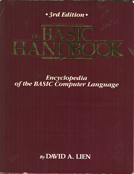 Sure, I worked during school and after I graduated, but my first job in “the industry” was working at a computer book publishing house. I think I started in 1985 or so, then left in 1987 to go it on my own. But my career began back then, working as a “technical writer” for CompuSoft publishing in El Cajon, California.
Sure, I worked during school and after I graduated, but my first job in “the industry” was working at a computer book publishing house. I think I started in 1985 or so, then left in 1987 to go it on my own. But my career began back then, working as a “technical writer” for CompuSoft publishing in El Cajon, California.
The headquarters for CompuSoft was across the street from my apartment complex. I began work at 8:00, which meant I got up at 7:50, put on clothes, and walked across the street.
Yes, in that order.
I began working in a bullpen of about 10 or so other technical writers and researches. Eventually they were all let go and only I remained. I was later told that I was hired to replace all of them.
The job consisted of coding program examples for the books, but also writing drafts of the final text. (I also managed the Microsoft Xenix system.) The publisher had only one author, Dr. David Lien, who was also the owner and publisher. So all the books had his name on them.
Dr. Lien wrote the original TRS-80 BASIC programming manual, as well as the original Epson MX-80 printer manual. He pioneered the colloquial writing style for technology books, which was unusual at the time. ComputSoft publishing basically took two of his books, Learning BASIC and The BASIC Handbook, and rolled them over into multiple titles for the different computers and operating systems available in the time. That was what the “technical writers” did.
The first project I worked on was Learning IBM Basic, which was a BASIC-language tutorial. I added appendixes on graphics program and disk access. Then I researched the update for the IBM Basic Handbook, an encyclopedia of GW BASIC. I finished my stint there researching and updating the author’s seminal work, The BASIC Handbook.
The reason I’m reminiscing — and there are plenty of tales I could tell about the place — is that I recently went looking for those titles in my personal library. I couldn’t find them! I thought I kept copies of all the books I worked on, but those three titles weren’t anywhere to be found. So I went to Amazon and ordered used copies.
It was kind of nostalgic to once again hold a copy of The BASIC Handbook, look inside and see my name in the masthead. Leafing through the text, I found code that I wrote 25 years ago. In some of the examples would be tiny clues I left to show that I wrote the thing.
My career at CompuSoft Publishing ended in 1987 when I hired a computer book agent to help market my talents. It was only four short years later that my agent hooked me up with Mac McCarthy at IDG Books, where I wrote DOS For Dummies. Upon reflection that’s a very short timespan, but living as a struggling author/computer nerd, it seemed a heck of a lot longer.


Im curious what kind of machine IBM BASIC would run on because by 1985 I thought that the IBM PC market was pretty well entrenched, and I thought Microsoft controlled the disc OS and the BASIC implementation on the PC. And what made “The BASIC Handbook” so seminal? I would think that by the mid-80s that the market would be flooded with BASIC books as everything…C-64, Atari, Apple II, etc ran BASIC.
Comment by BradC — December 7, 2012 @ 5:24 pm
The BASIC that ran on the PC was called BASICA. On the original PC, and possibly the PC-XT, BASIC was in ROM. BASICA was an extension that loaded on top of ROM BASIC. Microsoft wrote both. For the PC clones, you ran GWBASIC, which was the same thing.
CompuSoft Publishing took the Learning BASIC book and “rolled it over” for each of the different systems of the day. So there was a Learning Apple II BASIC and Learning Commodore 64 BASIC and so on.
The BASIC Handbook was a vital tool. Because a lot of coding was done in BASIC, and each BASIC was subtly different, programmers relied on the handbook to help them re-code their work for another platform. That way your BASIC program on the PC could be ported over to a CP/M machine, for example.
While most programmers I know would start out learning BASIC, they’re quick to understand its limitations. I recall only a handful of programs I used that were written in BASIC, and even then the BASIC was so scrambled that you couldn’t patch or tweak the code. So alternatives were sought out. For a while it was Pascal but eventually C took over as the language of choice.
Comment by admin — December 7, 2012 @ 6:27 pm
There is also the tradition of Programs being written in the language of the day. Whatever is being used in Schools/University of the day. I was taught Pascal at school, C at Uni (well C For Dummies, and a couple of question to you) and my First paying Job was in VB6 (why??) at a bit of C for embedded, Now it’s C# & C for embedded use. It seems I missed Java, Modula2. The issue is people tend to use what ever they have used in education and mash what they know to fit its application.
Comment by glennp — December 7, 2012 @ 7:10 pm